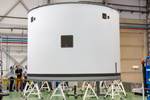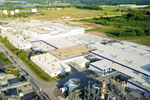Toray supplies Torayca carbon fiber, prepreg for H3 launch vehicle
Set to launch Feb. 15, the Japan Aerospace Exploration Agency rocket has been designed with a composite motor case and payload fairing section.
Toray Industries (Tokyo, Japan) announces that it has supplied the Japan Aerospace Exploration Agency’s (JAXA, Tokyo) H3 launch vehicle — the successor to its H-IIA rocket — with Torayca carbon fiber and prepreg. As it was used in H-IIA, the carbon fiber has been implemented in the H3 motor case (the part of the rocket body that stores solid fuel and serves as the combustion chamber) and Torayca prepreg, designed using high-strength carbon fiber and high-toughness resin, has been newly adopted for the payload fairing section (the leading edge of the launch vehicle where satellites and other payloads are loaded).
The H3 is JAXA’s new flagship launch vehicle aiming at achieving high flexibility, high reliability and high cost performance. The rocket is 63 meters high with a diameter of 5.2 meters. According to the JAXA specifications page, the rocket is “capable of delivering ‘4 tons or more’ to a 310-mile-high (500 kilometers) sun-synchronous orbit and ‘6.5 tons or more’ to geostationary transfer orbit. JAXA has planned the H3’s launch for Feb. 15, 2023.
Torayca prepreg, used in fairings, is a slit tape prepreg designed for the automated fiber placement (AFP) process, enabling efficient forming and processing of complex shapes and large structural materials, including oven forming, in addition to conventional autoclave forming.
In recent years, Toray notes that the use of satellites has expanded in various fields such as broadcasting, communications, positioning (GPS), Earth observation and disaster prevention, and the demand for launch vehicles has been increasing year by year. With the demand for lower launch costs and higher performance, the use of composite materials is expected to expand further in the future. Toray will continue to support such demand with Torayca products.
Related Content
-
Materials & Processes: Fibers for composites
The structural properties of composite materials are derived primarily from the fiber reinforcement. Fiber types, their manufacture, their uses and the end-market applications in which they find most use are described.
-
The potential for thermoplastic composite nacelles
Collins Aerospace draws on global team, decades of experience to demonstrate large, curved AFP and welded structures for the next generation of aircraft.
-
Materials & Processes: Composites fibers and resins
Compared to legacy materials like steel, aluminum, iron and titanium, composites are still coming of age, and only just now are being better understood by design and manufacturing engineers. However, composites’ physical properties — combined with unbeatable light weight — make them undeniably attractive.














